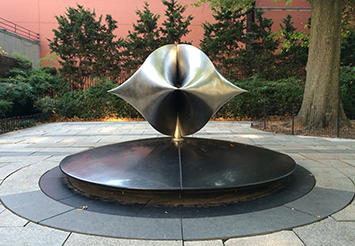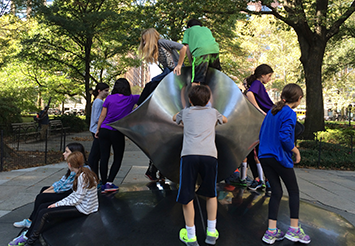Blog
Time and Place: Thoughts for the New Year
January 7, 2015
 In front of the Columbus Avenue side entrance to the American Museum of Natural History’s Rose Planetarium in New York City there is a sculpture by the architect Santiago Calatrava called the Times Capsule. (The plural “Times” rather than “time capsule” is used because it was commissioned by the New York Times.) Installed in 2001, the plaque at its base reads, “The contents are intended to offer insight into daily life today. We ask that it remain sealed until January 1, 3000.”
In front of the Columbus Avenue side entrance to the American Museum of Natural History’s Rose Planetarium in New York City there is a sculpture by the architect Santiago Calatrava called the Times Capsule. (The plural “Times” rather than “time capsule” is used because it was commissioned by the New York Times.) Installed in 2001, the plaque at its base reads, “The contents are intended to offer insight into daily life today. We ask that it remain sealed until January 1, 3000.”
As we gaze into the cloudy crystal ball of the future, the notion that on New Year’s Day 985 years from now someone will pry apart the sleek aluminum sides that seal this offering raises a few unsettling thoughts. Will the vibrant living city and the great museum that is one of its prime cultural treasures resemble anything we know today? Will there be a mayor ceremoniously announcing the findings inside the opened capsule? Will there will be a curious public reading about them on the front page of a still-published New York Times?
Face it: the message on the plaque is addressed to a team of archaeologists.
It is unsettling to conceive of ourselves as prospective members of a lost civilization. But jump backward in one-thousand-year increments of time, and the conclusion is inevitable. One thousand years ago brings us to the year 999 when, reputedly, end-of-the world predictions were rife. Printing presses were non-existent, and whatever apocalyptic visions found today in a hypothetical millennial time capsule from that date would have contained words written in Medieval Latin by monks on parchment. Except for their native populations, the Americas were terra incognito, unnamed and unexplored by Europeans. With no New World maps yet drawn and no Dutch mercantile traders yet born, who could even dream that New York City would become a world wonder with a population of eight million beckoning the historical interest of a future generation?
Take another thousand-year leap into the past and you are at the birth of the Roman Empire. Keep on time-traveling, and you reach the construction of Stonehenge. Yet another thousand-year jump in reverse lands you at the beginning of Egypt’s Old Kingdom. The remains of these civilizations are now tourist sites or meager fragments amassed in museum collections and libraries.
And yet, however transformed, place remains. Think of world geography as a series of palimpsests bearing the marks and erasures of time. In spite of all the erosion and alterations to places of the past and the mind-boggling transformation in the whole notion of place that today’s rapidly accelerating technological revolution has fostered, place is still a physical reality.
What then is the fate of geographical place? Take a grim look at Manhattan. One dire scenario would be submersion of its shoreline by rising seawater; another obliteration of its streets and buildings and parks by missiles, bombs, and drones dedicated to the destruction of America. Elsewhere, rampant capitalism and corruption threaten the loss of remaining habitats for wildlife—and human beings. Growing political instability worldwide is a fuse ready to ignite universal chaos.
But, bruised and ailing, the planet is still our human home, and the notion of interstellar colonization does not accord with our inherent attachment to place. For better or worse, the world is our garden.
In this light, it is useful to recall that both Medieval Christian and Muslim gardens are paradigms of paradise. Both have fountains from which runnels of pure water flow. Both have well-tended fruit trees and flowers. Both are places of ease and hospitality. Both are symbols of peace and promise.
 It was with these thoughts in mind that I stopped to admire Calatrava’s arresting sculpture one recent day when it was surrounded by a class of schoolchildren and teacher who was attempting to impart a history lesson.“What is this?” he asked. One of the several kids who were gleefully climbing and sliding around its inviting curvatures, promptly piped up, “A fortune cookie!”
It was with these thoughts in mind that I stopped to admire Calatrava’s arresting sculpture one recent day when it was surrounded by a class of schoolchildren and teacher who was attempting to impart a history lesson.“What is this?” he asked. One of the several kids who were gleefully climbing and sliding around its inviting curvatures, promptly piped up, “A fortune cookie!”
Well, what is the message inside the fortune cookie? Will the news clippings and cultural artifacts of today will give some indication that, whatever the prospects for enduring civilizations over the millennia may be, we will correct our course of environmental destruction and computer-assisted global warfare? Let us hope then that 2015 will be a moment in our own sliver of time when we recognize our profound responsibility to understand, respect, and enhance the meaning of place.
![]()
Betsy
P.S. The mission of the Foundation for Landscape Studies is “To promote an active understanding of the meaning of place in human life.” Please help us to continue this work now and in the future. Donate.
